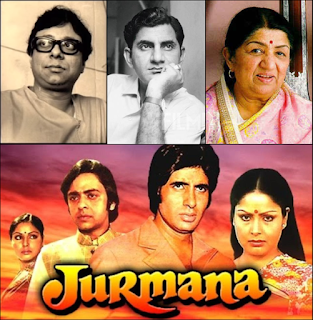Sawan Ke Jhoole Pade Hain
Jurmana – Sawan Ke Jhoole Pade Hain
There are some songs that appear twice in a Hindi film. It's either a happy and a sad version or sung solo by different artists. Some of RD Burman's such songs are-
Mere Naina Sawan Bhado - Lata and Kishore
Hamein Tumse Pyar Kitna - Parveen Sultana and Kishore
Chandni Re Jhoom - Lata and Kishore
Hum Bewafaa - Kishore (happy & sad versions)
Tum Bin Jau Kaha - Rafi & Kishore
Yaadon Ki Baarat - Lata and Rafi-Kishore
There are just too many examples. One such song in this list is Sawan Ke Jhoole Pade Hain sung by Lata Mangeshkar and penned by Anand Bakshi for Jurmana (1979). Set in Raag Pahaadi, the faster version has a 7 beat Rupak Taal (somewhat like the beats of Chupke Chupke Chal Ri Puraviayya).
The slower version has a minimalist and simple music setup. The interesting part about this song is that, the Mukhda of this song does not have a rhyme scheme. Those are plain Hindi words like a sentence – “सावन के झूले पड़े, तुम चले आओ”
Mere Naina Sawan Bhado - Lata and Kishore
Hamein Tumse Pyar Kitna - Parveen Sultana and Kishore
Chandni Re Jhoom - Lata and Kishore
Hum Bewafaa - Kishore (happy & sad versions)
Tum Bin Jau Kaha - Rafi & Kishore
Yaadon Ki Baarat - Lata and Rafi-Kishore
There are just too many examples. One such song in this list is Sawan Ke Jhoole Pade Hain sung by Lata Mangeshkar and penned by Anand Bakshi for Jurmana (1979). Set in Raag Pahaadi, the faster version has a 7 beat Rupak Taal (somewhat like the beats of Chupke Chupke Chal Ri Puraviayya).
The slower version has a minimalist and simple music setup. The interesting part about this song is that, the Mukhda of this song does not have a rhyme scheme. Those are plain Hindi words like a sentence – “सावन के झूले पड़े, तुम चले आओ”
There is no Yamak (यमक or काफ़िया) in the Mukhda and yet it is RD’s
brilliance that we do not even notice this!
First the slower version. This song is picturized in the
mountains on a younger Rakhee-Amitabh when they are in courtship. Her character
is that of an aspiring singer. Considering this, there aren’t any harkat’s
in the singing. Plain and simple rendition of words as would be done by an
amateur singer. The only beauty points added are the extensions provided to the
words of each Antara.
Sample this-
आँचल ना छोड़े SSSS मेरा SSS, पागल हुई है पवन SSSS अब क्या करूं मैं जतन SSSS,
धड़के जिया जैसे, पंछी उड़े SSSS
Note how the lyrics denote the progression of her thoughts. In the first Antara (above) its about the state of her heart. In the second Antara she wishes for him
दिल ने पुकारा उन्हे, यादों के परदेस से आती है जो देख के, हम उस डगर पे हैं कबसे खड़े
The song starts with her humming. It gets its pickup on vibraphone and strums on the Guitar. These are joined by Resso Resso and Madal.
Common strain between both the songs is the use of violins.
The violins provide totally different harmonies in both the versions. While they
are used to provide background melody in the slower version, they complement
the rapid (Drut, ) pace of the other version.
The Taal (ताल) mostly on Tabla is a vilambit laya (विलंबित लय, at a slow
pace). It’s a simple monochrome type rhythm. The pace continues without any
change in the first Antara on the Accordian. Note the support on the Violins
all the time.
The second Antara has Sitar followed by shrill Violins to
depict the entry of the other protagonist Vinod Mehra. (A love triangle).
https://youtu.be/cf3sesBDqDA
Now for the more popular faster version:
For the full song and a better audio quality
https://youtu.be/vqIVoibGPGA
or for the film picturization of the song
https://youtu.be/0VbyQ5tdavI
The main difference between the two versions is the लय (Laya, tempo) on the Tabla and the Violins. A fuller
orchestra, a fuller and faster rhythm and yet the presence of each instrument
is felt. Unlike the slower version, this one starts with an Aalap (आलाप) by Lata
immediately followed by the song joined in by Tabla and Guitar. Violins join in
the second line of the Mukhda and stay till the end.
After listening to the use of
violins in the first version we can truly appreciate the mastery of those
involved in creating this song. The entire mood is different. Tabla is fast
paced in drut Laya (द्रूत लय) like a Rupak (रुपक). The filmy version has two Antara’s while the LP
has three Antara’s.
The first interlude music is
unlike the short ones that RD uses. Here we have elaborate pieces on Sitar and
Santoor. In this version of the song, Rakhee’s character has matured and so is the
singing. So, in addition to the extended swar’s we also have small harkat’s (हरकत) in
the song. Notice the Haaa Haaaa towards the end of the antara.
This version has the same Antara’s as the slower version, where she just longs for him but shies from giving her relationship a name. It's only in this Antara that she calls him Piya and that seals the song!
जब हम मिले पिया, तुम कितने नादान थे हम कितने अन्जान थे, बाली उमरिया में, नैना लड़े सावन के झूले पड़े, तुम चले आओ


Comments
Post a Comment